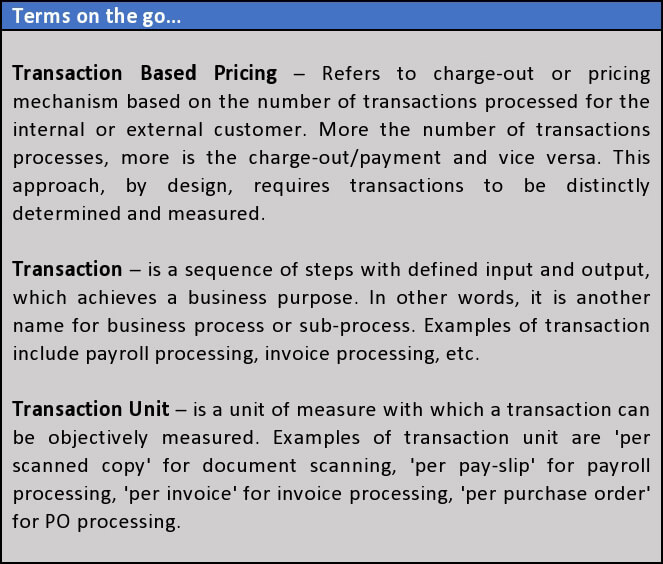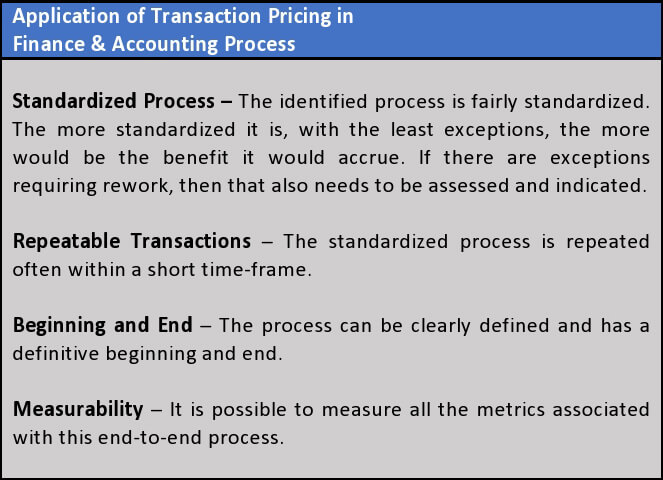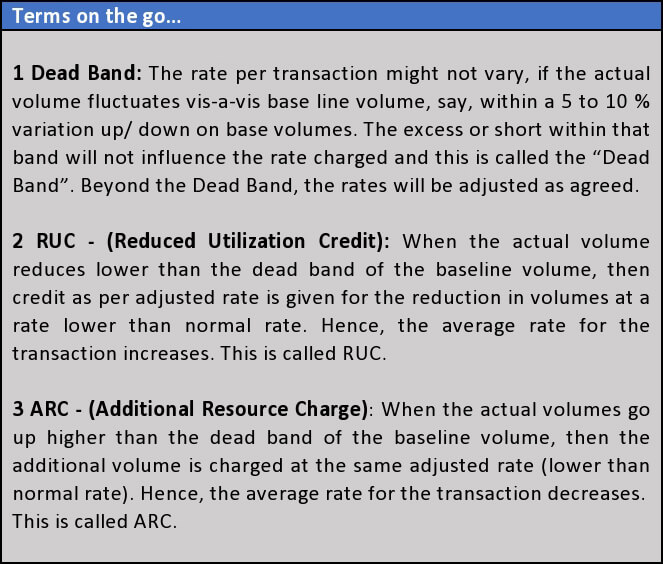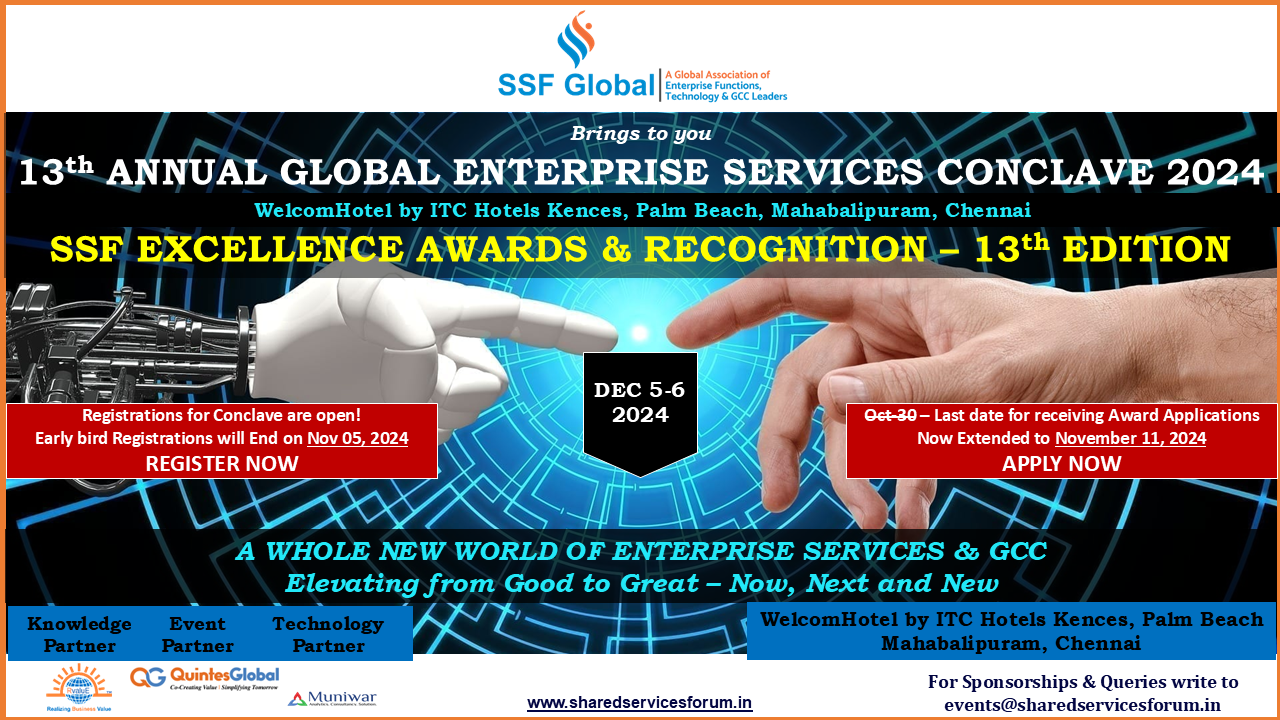
Would you like to start a conversation with other industry leaders to brainstorm a challenge or to just know more on a particular topic?
Engage in online discussions with your Peers
Start NowOver last 2 decades, Organizations have taken serious steps to simplify transactional processes in all staff functions like processing of invoices, claims, payroll or purchase orders, to make them ‘rule based’ and consolidate these transactions to reduce cost or increase efficiency or enhance effectiveness. The foundation of such an initiative within staff functions is to better understand the concept of ‘fully loaded cost’ or the total cost and the ‘cost of processing transactions’ to design actions/ measures to progress from ‘reducing cost to effectiveness’ continuum!
“Regardless of how it's done, transaction costs will continue to plummet
as computers get more powerful. Low transaction costs are a wonderful thing if
you're in the transaction business. They're wonderful for consumers too, making it
cheaper and easier to buy things and creating new things to buy.”
- Nathan Myhrvold
Fully Loaded Cost
The concept of ‘fully loaded cost’ (FLC) and its computation is a challenge for many organizations since they merely consider the ‘cost of labor’ while attempting to establish the cost of consolidated transactional processes. In real terms, besides the cost of labor, there are many other costs like hardware, software, furniture, space occupied, employee related expenses, management oversight, administration & HR management etc., that are to be aggregated to estimate the ‘FLC’ with reasonable levels of accuracy.
Different pricing mechanisms have evolved in the last several years to create value proposition to the internal customers/clients, apart from flexibility and creating a win-win partnership.
The emergence of a strong Shared Services has brought significant focus to the elements of fully loaded costs in staff functions like BFSI Operations, F&A, HR, Procurement etc.,. Companies, while setting up captive shared services (SSC), need to treat the SSC as a separate ‘business unit’ (to provide services to internal business units/customers) to establish the FLC of each major process and as more experience is gained, ensure sustained improvements to refine cost estimations. The BPO sector, with their ‘core business of business processes’, has focused to track and monitor FLC, and adopt varied pricing models to differentiate themselves in the market place.
Pricing Models
Different pricing mechanisms have evolved in the last several years to create value proposition to the internal customers/clients, apart from flexibility and creating a win-win partnership. Broadly, these pricing models can be classified into:
- FTE (Full Time Equivalent) Based - Number of Headcounts deployed irrespective of volumes
- Transaction Based (per unit of transaction like invoice, pay slip, claim, purchase order etc.,)
- Business Outcome Based (revenues, collection, reduction in cost etc.,)
While the FLC continues to form the base for any model to determine margins, each of the above costing/pricing mechanisms has some criteria on their applicability over a particular business process and the corresponding value it can create for the Company or SSC/ BPO. Typically, FTE Based is usually the starting point and then organizations graduate to Transaction Based for certain select processes that lend themselves for such a model. Outcome Based is largely used where the linkages of the process to business outcome can be established.
The FTE Based cost is a big step forward for processes of staff functions as proper aggregation of all relevant costs, by itself, requires huge change in mind-sets besides skillsets associated with such computation. Establishing ‘charge-outs’ (the pricing mechanism) i.e. ‘FLC plus Margin’ methodology, is even more a challenge, as it is one of the best practices from SSC to internal business units. Having said, FTE Based approach tends to be ‘fixed cost’ oriented and does not move towards variability of costs.
Transaction Cost/Pricing
Graduating to transaction based pricing from FTE Based approach brings specific focus on number of transactions and opportunities to address fluctuations in volumes in various months due to seasonality of business or change in business cycles. Organizations can convert the fixed FTE cost/ price (for processing transactions) into variable to the extent possible, and handle volume fluctuations as well as focus on aggregation of volumes to result in overall reduction, without affecting the business. Today's SSCs or BPOs strive to provide this possibility as the services are not just about 'economies of scale', but about 'economies of specialization'!
Transaction Pricing lends itself towards to the above objective. This model encourages both the service partners (SSCs/BPO) and their internal/ external clients to act in an economically efficient manner in developing a successful partner relationship. Creating and developing this requires service partners to share technology and their associated standards, develop collaborative business processes, implement best practices, adopt agility, data security and compliance in setting a comprehensive platform/ digital based environment

Determining the right process as well as the right transaction unit, therefore, is important to transaction based pricing. For instance, Invoice Processing (for PO + Non PO) could be a ‘transaction’ while in some other cases, PO Based Invoices and Non PO based invoices can be considered as two different transactions/ units, since the underlying transaction, in terms of operational processing and the costs related could differ with processing that transaction.
Pre Requisites for Transaction Based Model
Broadly, the 3 key parameters to choose a process for Transaction Based Pricing Model are ‘Repeatability, Reproducibility and Measurability’, and they characterize the essence on which it works. In short, the business process that can be best amenable to TBP is that which can be clearly defined and measured in discrete units. The details are:

In Transaction Based pricing, what and how many resources are required or how much time is taken to process a transaction while meeting quality and Service Level Agreement (SLA) norms, are variables that are typically managed by service partner like SSC/BPO. This essentially means that productivity becomes the main criteria and variability/risk due to volume fluctuations is transferred to service partner.
The typical application of Transaction Based Pricing starts in the most common process like Accounts Payable from transactional processes such as Invoices Processed (PO/ Non PO) and Number of T&E reports (Domestic & Foreign), which have a great degree of rule based standardized processing. Service Partners and customers should work closely to align and enable all the critical parameters in the pricing mechanism to create a sustainable and successful working model.
The following list of parameters influence the pricing and are also the productivity factors:
- Setting up the baseline volumes
- PO/Non PO based invoices
- Number of line items
- Exception processes
- Higher degree of automation
- 1st pass yield, which has an impact on productivity
- Number of payment runs
Transaction Pricing Mechanism
Transaction pricing is based on the number of transactions processed. However, the rate per transaction might not remain same and might vary if there are volume fluctuations compared to base line volume.
Specific terms associated with this model are used – Dead Band, Reduced Utilization Credit (RUC) and Additional Resource Charge (ARC) - to ensure common understanding and alignment for implementation. The reason is that the service partner creates the overall resource environment and investment based on the baseline volume and there is a need to cover costs and margins for these fluctuations. The RUC/ ARC may be applicable on a monthly, quarterly, half yearly basis, as per the arrangement with the internal/ external customers.
Besides the volume fluctuations, this model can also build a higher charge for rework transaction volumes due to input deficiencies. Transactions on rework can be charged at 25% or 50% of the base rate during the first review, and full rate be charged when the transaction is fully processed, thereby leading to 125% or 150% charge of the base rate.
The terms are explained below, with a simple example:

Examples
Let us assume that the baseline volume is 20,000 Transaction Units a month, the Dead Band is +/- 10%
(2000 units), the transaction price is INR 50, and the ARC/ RUC price is fixed at INR 5.
Scenario 1: Dead Band
If the month’s transaction units fall within the range of 18,000 (20,000-2000) to 22,000 (20,000+2000), the rate does not get affected, since it will be within the Dead Band.
Scenario 2: RUC
If the month’s volume falls by 3000 units from the baseline volume of 20,000, which will be 17,000 units then the price will be determined as follows: (20,000*50 - 3000*45)/ 17,000 = INR 50.88
Scenario 3: ARC
If the volume increases by 3000 units from the baseline volume, which will be 23,000 units then the price will be determined as follows: (20,000*50 + 3000*45)/ 23,000 = INR 49.35
A point of caution here is that while the RUC may be fixed at INR 5, sometime the ARC could be lower, or even zero. This is because during a period of reduced volume, resources continue to be deployed, though not fully utilized. However during a period of increased volume additional resources have to be necessarily deployed to meet the other SLA parameters, such as Turnaround Time.
Leverage Derived from Platform Based Approach in Transaction Pricing
Quite often, transaction pricing has a greater impact when the process is backed by technology that is owned by the service provider. This gives access to shared infrastructure, best practices, adoption of latest technologies and economies of scale/ specialization among other benefits. Many large volume transaction processes built on this approach to pricing leverage platform based technology:
- Technology – The Technology platform can be utilized among multiple BUs/customers across process, so the on boarding of additional BUs/customers into the environment is less complex and the time-to-market is pretty quick. The client gets the advantage of the best-in-breed technologies, without any significant investment.
- Process – Process harmonization and standardization enables a predictable outcome and also complements a control & compliance environment. This gives a tremendous advantage for mining ‘structured data.
- Infrastructure & Security – Cloud based and SaaS environment give distinct leverage on lesser set-up cost, less down time and fear of obsolescence of the technology infrastructure around which it is implemented.
- People – De-skilling, ease of on-boarding and availability of leveraged cross-trained resources enable to manage temporary fluctuations across different customers. Hence, the service partners are able to provide a risk free environment to the customer as they need not worry about volume fluctuations.
Eventually, a successful operation is one when costs are reduced, service levels are improved and customer satisfaction/engagement is increased.
Service partner is equipped to manage this risk by utilizing resources efficiently across multiple BUs/ customers/ processes. In addition, service partner is motivated to maximize output or number of transactions processed with same or lesser input, which typically leads to innovation and better use of technology resulting in lesser cost for customer in the ultimate analysis.
The Best Way to Begin...
Organizations setting up Shared Services for processes of Staff Functions like F&A, HR, BFSI/ Telecom Operations or planning to outsource such processes to a Third Party BPOs will immensely gain by focusing on cost/ pricing elements right from the start to build the relevant cost structure as well as the required BPM culture. The key actions for adopting a cost/ pricing model are summarized below:
- Proper determination of FLC as the foundation for understanding the aggregated cost of processes. This in itself a big first step!
- Shared Services are best treated as a separate business unit while setting up, and based on FLC, commence with establishing FTE Based Cost for each major process.
- Preferably, create a ‘charge-out’ mechanism for internal customers of SSC based on FTE based cost. This might also require comparing the FTE based cost of SSC with current costs for BUs to demonstrate saves over a period of time. In outsourcing, FTE based cost as a pricing model is given, and for a specified headcount number for each process
- Transaction based pricing is a valuable model. This approach demands certain basic requirements are met like base line volumes, service level metrics, standard technology enabled process, understanding of key drivers to determine the transaction unit and exceptions, range of volume fluctuations etc., Quite often, it requires some minimum time to mature the operations and relationship between service partner and customers
- Transaction based pricing model can be applied by establishing a working model and to processes like Accounts Payable or BFSI Operations or help desk calls for IT etc.,
- Collaborative partnership between Service Partner and Customers will ensure greater process improvements. Like, Rework transactions when charged higher rates can enable joint focus to reduce the exceptions or aggregation of volumes can bring down the overall number of transactions, with the right gain sharing built in for such improvements.
Overall, cost focus and resultant pricing mechanism is a great starting point to move towards quality, service, process improvements and creating value.
Progress is impossible without change, and those who cannot change their minds cannot change anything. - George Bernard
ABOUT THE AUTHOR

Sivaram Vallampati is currently the Global Transformation Leader at HP for their Global Business Services operations. He comes with over 20+ years of experience, having worked in Global Business Services for over 13 years with SCOPE, Oracle, iGate and with few leading Tech Companies like Polaris and Servion in their Finance function. He has set up operations from the very beginning and has handled transitions as well as managing large F&A operations and teams. He is strong in strategic thinking and has initiated and implemented several new and innovative concepts to transform operations, client delivery, business expansion and value creation. He is a CA and ICMA.









